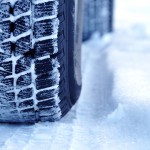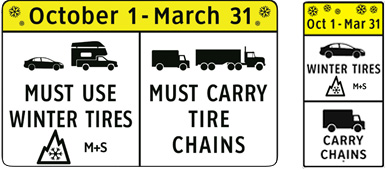Winter Tires and Those New Signs
 I just got my winter tires put back on my car. I never used to have them, but when I bought my new car the dealer gave me a set on rims, so I’ve become a convert. I love the increased traction in heavy rain, icy conditions and snow, especially as I have family living in Whistler now.
I just got my winter tires put back on my car. I never used to have them, but when I bought my new car the dealer gave me a set on rims, so I’ve become a convert. I love the increased traction in heavy rain, icy conditions and snow, especially as I have family living in Whistler now.
Why winter tires?
Here’s an explanation from Canadian Tire: Regular all season tires lose elasticity when the temperature dips below 7°C/45°F. Winter tires are constructed with a special compound that allows them to retain more elasticity in cold temperatures. Technologically engineered tread designs prevent snow build-up and improve ice and snow traction—so you get a better grip on the road and better control of your vehicle.
It was during a visit to Whistler last summer to visit my son that I noticed signs warning motorists about winter tires and then I saw signs blossom on the Trans Canada leading up the Malahat Drive out of Victoria. When I mentioned it to friends it seems that everyone had an option on what was allowed and what wasn’t and when the police could ticket you for driving on the wrong tires. So, I thought I’d do some investigative journalism and put the record straight for all readers of the Accent Inns blog. After all the Accent Inns team most certainly want you to arrive safely and preferably without having been given a stiff fine.
Here’s a sample of the signs I’m talking about:
 The ruling is: “Should you go beyond the signs without the proper equipment you may be turned around by RCMP, CVSE or another policing agency, and be subject to a fine.”
The ruling is: “Should you go beyond the signs without the proper equipment you may be turned around by RCMP, CVSE or another policing agency, and be subject to a fine.”
The provincial government ruling (for cars) is as follows:
- From October 1 – March 31 you must obey winter tire and chain signs on all BC roads.
- The province recommends all drivers install mountain/snowflake tires for cold weather driving and, for extreme conditions, carry chains.
- Where the road is signed, the province allows tires that have the 3-peaked mountain and snowflake symbol OR the M+S (mud and snow) symbol, with at least 3.5 mm tread as winter tires (less than this and they are not considered winter tires so beware):
- 3-peaked mountain and snowflake symbol (sometimes called mountain/snowflake or alpine tires) – these offer the best traction on snow and ice, and perform better in cold weather
- M+S (mud and snow) symbol (all season) – better than summer tires but obviously not as good as the 3-peak ones.
- Chains – do not use these on summer tires, doing so does NOT meet the requirements of signage telling drivers they need the winter tires mentioned above.
- Just because you have winter tires doesn’t mean you are legal. Some people drive with different make tires on different axles. Here’s the legal verbiage from the Ministry: “You must have at least 2 matching winter tires on the primary drive axle, but we recommend using 4 matching tires on the four outside corners of the vehicle – even when driving a 4X4 vehicle. Mixing tires with different tread patterns, internal construction and size compromises stability, and should be avoided.” Now whether you would get ticketed is a moot point, however it’s best to be safe than sorry!
Okay, hope you got all that – now here’s an exception:
- Due to a more temperate winter climate in the Lower Mainland and southeastern Vancouver Island, drivers are not required to use winter tires (except where otherwise signed e.g. the Malahat) although many drivers choose to use M+S tires year-round.
5 Types of Tire
Studded Winter Tires
For serious weather, for instance the Coquihalla in winter. They need to be on all four wheels (illegal to have them only on the front) and should only be used October 1 – March 31.
Non-Studded Winter Tires
These perform best when you have to drive on ice and snow and it’s below 7-degrees Celsius. These are the ones with the mountain/snowflake emblem. Aggressive tread and rubber that stays softer in cold temperatures.
All-Weather Tires
These are a newer type of tire, not to be confused with all-season tires. They again have the 3-peaked mountain and snowflake on the sidewall. Good in temperatures above and below 7-degrees Celsius. They are becoming popular because the can be left on your car all year round and perform well in any weather. Beware though; they are NOT as good as winter tires in cold temperatures.
All-Season Tires
Although these feature the symbol M+S (Mud and Snow) on the sidewall, they really should be called 3-season tires. They are better than summer tires but don’t perform well when the mercury dips below 7-degrees Celsius.
Summer Tires
It goes without saying – don’t drive with summer tires in the winter, they are built for speed and agility and are ideal for high performance cars. They offer superior grip in warmer weather but in winter raining, icy and snowy weather can be downright scary!
Mike Wicks
Blue Beetle Creative